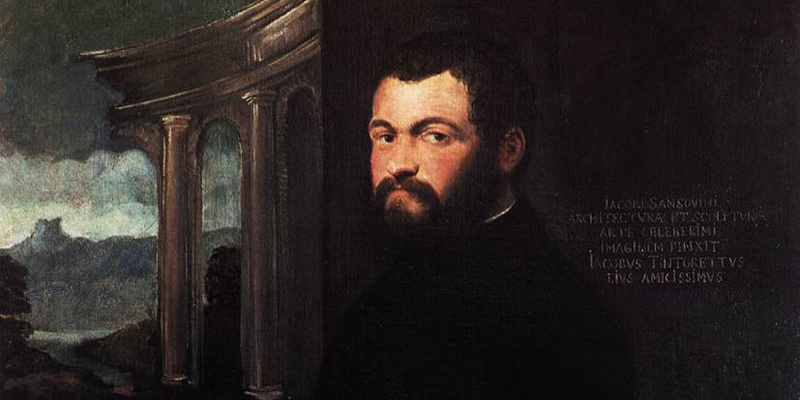Jacopo Tatti, called the Sansovino (Florence, 1486 - Venice, 1570) was an Italian architect and sculptor. It was the Proto (maximum architect) of the Republic of Venice from 1529 until his death. He began his artistic apprenticeship in the workshop of Andrea Contucci, called Il Sansovino, from which it inherited its nickname.
He travels to Rome in 1506, accompanied by Giuliano da Sangallo il Giovane, but his first independent works are documented only from subsequent return to Florence from 1511 where he received commissions for marble sculptures like San Jacopo Apostolo for the cathedral and a Bacco, now in the Bargello Museum.
Also in Florence participated in the competition for the construction of the Loggia del Mercato Nuovo without winning it. Best outcome was the competition for the Basilica of San Giovanni Battista dei Fiorentini in Rome in which also participated Raphael, Antonio da Sangallo il Giovane and Baldassare Peruzzi. His design was chosen, but due to technical difficulties, left the site shortly after the start delegating in Antonio da Sangallo.
His second Roman period (1516-1527) is characterized by the development of a style more greater, like in the Madonna del Parto in Basilica di Sant'Agostino (1521), the Sant'Antonio, today in San Petronio in Bologna and the tombs of Cardinale Sant'Angelo. As architect renovated the chapel (and possibly other architectural elements) in San Marcello al Corso, which was destroyed by fire in 1519, and built the Palazzo Lante, which marks the first work where his style begins to be evident.
Venice 1527-1570
He escape from Rome after the Sack of 1527, sheltering in Venice, where he just wanted to pass the long in direction to France. Instead, he remained in the city after being presented to the Doge Andrea Gritti by Cardinal Grimani, after receiving an immediate commission for the restoration of the domes of the Basilica of San Marco. He settled in Venice and only left of the city for a trip to his hometown in 1540.
He was the first architect in the city of canals to introduce the monumental style of the Renaissance mature, although adapted to the architectural characteristics of the city.
Probably participated in the reconstruction of the Procuratie Vecchie, in the final phase of the work, and from this intervention took the form the project of total renovation of Piazza San Marco, including the building of the Biblioteca Marciana (until 1546), the Loggetta del Campanile (1537 – 1540) which also sculpted reliefs and statues in the niches, and finally the Procuratie nuove building continued, cause of his death, Vincenzo Scamozzi and Baldassare Longhena, the first of which modified the original design of the Sansovino, adding to the building an additional floor, raising it with respect to the Marciana Library. Sansovino was appointed Proto of the Republic, the maximum architect, in 1529, a prestigious position he held until his death.
At the time of the renovation of the square, Sansovino was also the author of the Chiesa di San Geminiano, masterpiece destroyed by Napoleon, who built the current Napoleonic Wing. Another work destroyed following the Napoleonic suppression is the Chiesa di Santo Spirito on the homonymous island in the lagoon, of which today only remain the perimeter walls.
Other Venetian works are the interior of the church of Santa Maria della Misericordia, the Zecca (1536-1540), the Palazzo Corner on the Grand Canal (since 1537), the Chiesa di San Francesco alla Vigna (1534 completed by Andrea Palladio), the Chiesa di San Martino (1540), the altar of the Assumption by Titian in the Frari Church (1543) and the golden staircase in the Palazzo Ducale (1554).
As for his work as a sculptor in Venice, there are numerous marbles and bronzes sculptures, such as the Madonna and Child in the Arsenal of Venice (1534), the sculptures, the gate of the sanctuary and the bronze door of the Sacristy of St. Mark's Basilica (1537-1546) and John the Baptist for the Church of the Frari (1540-1550).
His masterpiece is the Biblioteca Marciana, one of Venice's most richly decorated Renaissance structures, which stands in front of the Palazzo Ducale. The construction spanned 50 years and cost over 30,000 ducats. In this building he successfully made the architectural language of classicism, traditionally associated with severity and restraint, palatable to the Venetians with their love of surface decoration. Andrea Palladio, in the preface to his Quattro Libri was of the opinion that Sansovino's Marciana Library was the best building erected since Antiquity.
Thanks to his friendship with Pietro Aretino and Titian was admitted into the Venetian nobility. At his death he was celebrated as one of the most remarkable and influential architects of the Venice Republic. He was succeeded like Proto (maximum architect) of the Republic of Venice by Andrea Palladio.
He died in Venice and his sepulchre is in the Baptistery of St. Mark's Basilica. His son Francesco Sansovino was an important literary and art critic.


